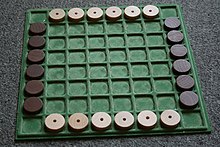LOA
LOA (Lines of Action), abstract game between two players created by Claude Soucie. Use an 8x8 board and 12 pieces for each player, black and white.
Home
It contains a couple of ingredients that make it an especially recommendable game: its unusual movement system and the strange effect (both beneficial and detrimental) of captures.
Here is the setup at the start of the game:
Movements
Alternately, the players will compulsorily move one of their pieces. Black moves first. It moves following a straight line (horizontal, vertical or diagonal), as many squares as there are pieces on that line (counting own and enemy pieces, including the piece that moves).
Figure 2 shows an example. Black starts by moving his piece onto the c8-square, and decides to move along the vertical.
Since above the line "c" there are two checkers, it moves exactly two squares, up to c6. Other options for Black would be, for example, to move to the e6 square, or to the a6 square (capturing the white piece, as we will clarify later).
Now White plays, and decides to move his piece onto c6 (figure 3). On the horizontal 6 there are three chips: two white and one black. In the event that White wanted to move along the horizontal, the white piece would reach the vertical "d".
However, it cannot do so, since it is not allowed to jump over enemy pieces (the one on c6).
Okay, White moves down the diagonal two squares, to c4.
Figure 4 reflects one of the possible responses of Black moving from e8 to b5.
You can check by example that it is possible to jump over your own tiles. However, more than one token is not allowed on the same square.
(White, for example, cannot respond by moving from a4 to c4).
Captures
You can see in figure 5 the next move for White, who moves from h3 to f1, capturing the black piece.
The captured token must be removed so it can no longer be used during the game. Thus, to capture, it is enough for a piece to finish its movement on the square occupied by an enemy piece.
Ending
The player whose tiles form a single concatenated group wins. It is possible to achieve it after your own movement or even thanks to an opponent's movement. The connection can be horizontal, vertical or diagonal.
The player who has only one tile left on the board also wins, since his opponent captured the rest, since it is understood that he has all his tiles connected by having only one tile.
It is possible that after a capture a player achieves a winning position and, at the same time (by having eliminated, for example, an isolated piece of the adversary) helps to create a winning position for the opponent. In this case the game is declared in Draw.
In the figure below, if Black moves he would win by moving f6->f4, or else f6->d4.
In this way, Black would manage to connect his five pieces. The capture e3 x g5 would lead to a draw: Black would connect, but at the same time it would give White the victory, leaving him only one piece. Capturing f6 x h8 is catastrophic for Black, as it leaves White alone on g5 and therefore wins the game.
Should White move first, he would win by moving g5->g8 and cause a draw with the capture h8 x f6.
Tactics in LOA
In order to study the LOA rules in operation, let's analyze a starting position.
See figure 7. Black to play. White threatens to win after two moves:
- a2/06c2
- c2.
What can black do?
The move b4>d2 even helps White: there are now three checkers on the horizontal line, which would allow White to move a2>d2 and win.
In case of moving b3>c2, blocking the white route along line 2, White would win by moving a2xd5, unfeasible move before.
The reader can train himself by looking for other options for Black. Subsequently, having found an adversary to practice the game, it must be taken into account that there are various tactics to hinder the enemy's plans and facilitate the achievement of one's own:
- Block the roads, interposing own files.
- Change the number of chips on a line to modify the possible movements.
- Capture the chips that unite, that is, chips without which a group is divided.
- To force the opposite of capturing those our chips that we find difficult to connect with the main group.
Well, here's a rich and dynamic game whose games, right from the start, provide skirmishes across the entire board and where the smallest slip-up can lead to catastrophe.
Fonts
- Sackson, Sid (1969). 'A Gamut of Games'. ISBN 0-486-27347-4
Contenido relacionado
International Chess Federation
Annex: Tennis at the 2004 Athens Olympics
Billiards
Horseshoe (game)
Lebanon at the Olympics







